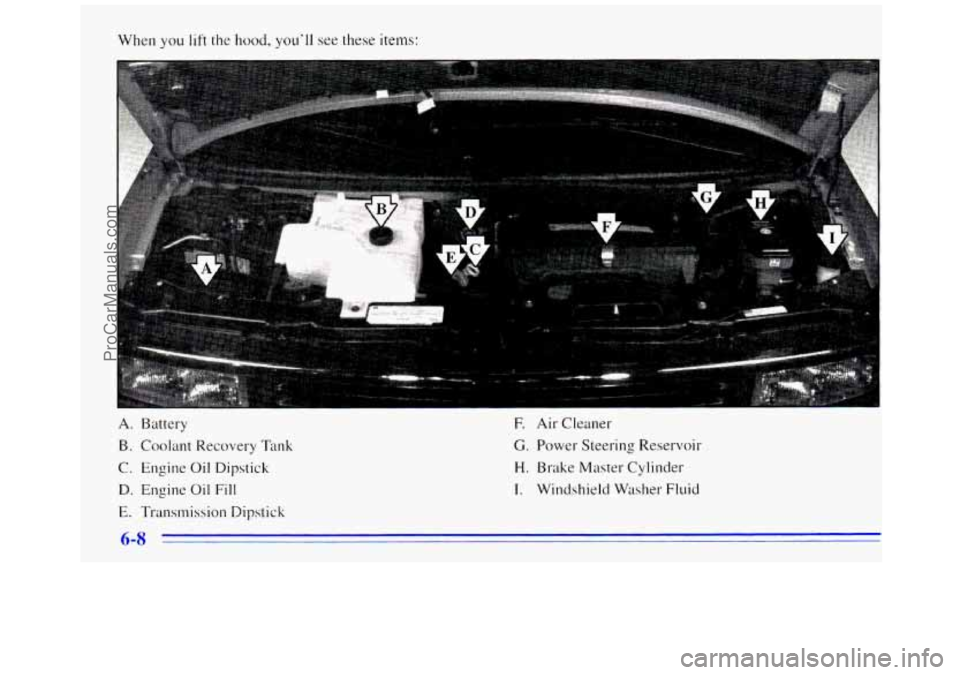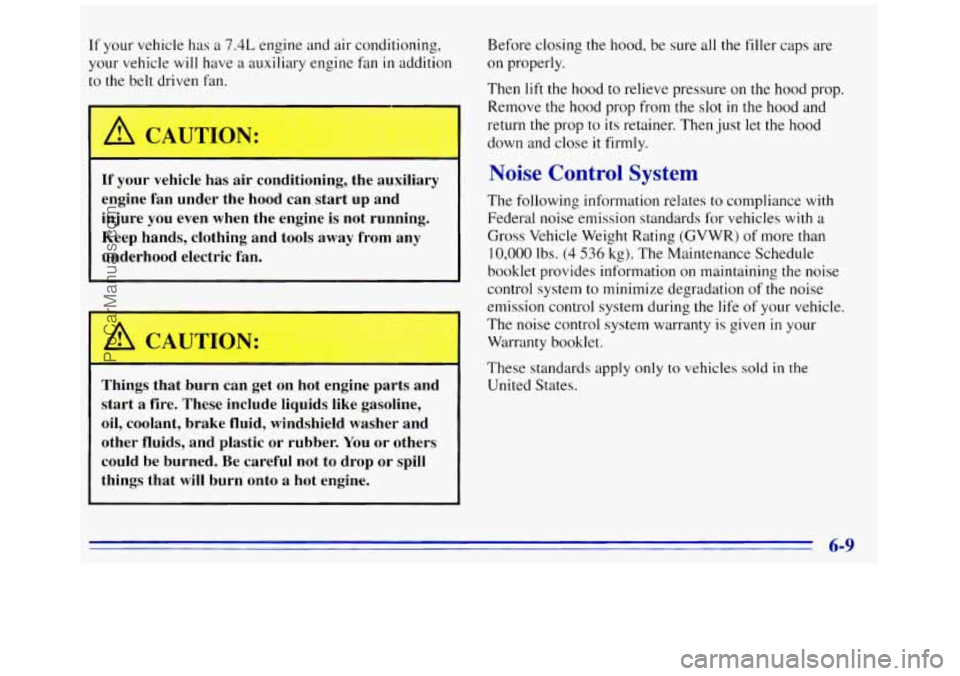1996 GMC SAVANA washer fluid
[x] Cancel search: washer fluidPage 90 of 372

Windshield Washer
At the top of the lever, there’s a paddle with the word
PUSH on it. To spray washer fluid on the windshield,
push the paddle.
Washer fluid will spray as long
as you push the paddle.
When
you let go of the paddle, the wipers will continue
to wipe for approximately two more wipe cycles and
then either stop or return to the preset speed.
Driving without washer fluid can be dangerous.
A
bad mud splash can block your vision. You could hit
another vehicle or
go off the road. Check your washer
fluid level
often.
Cruise Control (Option)
With cruise control, you can maintain a speed of about
25 mph (40 km/h) or more without keeping your foot
on
the accelerator. This can really help on long trips.
Cruise control does not work at speeds below about
25 mph (40 km/h).
When you apply your brakes, the cruise control
shuts off.
In freezing weather, don’t use your washer until
the windshield
is warmed. Otherwise the washer
fluid can form ice on the windshield, blocking
your vision.
Cruise control can be dangerous where you
can’t drive safely at a steady speed.
So,
don’t use your cruise control on winding.
roads or in heavy traffic.
slippery roads. On such roads, fast changes in tire traction can cause needless wheel
spinning, and you could lose control. Don’t
use cruise control on slippery roads.
Cruise control can be dangerous on
2-32
ProCarManuals.com
Page 163 of 372

Driving in Rain and on Wet Roads
Rain and wet roads can mean driving trouble. On a wet
road, you can’t stop, accelerate or turn as well because your tire-to-road traction isn’t as good as
on dry roads.
And,
if your tires don’t have much tread left, you’ll get
even less traction. It’s always wise to
go slower and be
cautious if rain starts to fall while you
are driving. The
surface may get wet suddenly when your reflexes
are
tuned for driving on dry pavement.
The heavier the rain, the harder it is to see. Even if your
windshield wiper blades
are in good shape, a heavy rain
can make
it harder to see road signs and traffic signals,
pavement markings, the edge
of the road and even
people walking.
It’s wise to keep your wiping equipment in good shape
and keep your windshield washer tank filled with
washer fluid. Replace your windshield wiper inserts
when they show signs of streaking or missing areas on
the windshield, or when strips of rubber start to separate
from the inserts.
4-15
ProCarManuals.com
Page 171 of 372

Winter Driving
Here are some tips for winter driving:
Have your vehicle in good shape for winter.
You may want to put winter emergency supplies in
your vehicle.
Include an ice scraper, a small brush or broom, a supply
of windshield washer fluid, a rag, some winter outer
clothing, a small shovel,
a flashlight, a red cloth and a
couple
of reflective warning triangles. And, if you will
be driving under severe conditions, include a small bag
of sand, a piece of old carpet or a couple of burlap bags
to help provide traction. Be sure you properly secure
these items
in your vehicle.
Driving on Snow or Ice
Most of the time, those places where your tires meet the
road probably have good traction.
However,
if there is snow or ice between your tires and
the road, you can have
a very slippery situation. You’ll
have a lot less traction or “grip” and will need to be
very careful. What’s
the worst time for this? ”Wet ice.” Very
cold
snow or ice can be slick and hard to drive on. But wet
ice can be even more trouble because
it rnay offer the
least traction
of all. You can get wet ice when it‘s about
freezing
(32°F; OOC) and freezing rain begins to fall,
Try to avoid driving on wet ice until salt and sand crews
can get there.
4-23
ProCarManuals.com
Page 232 of 372

When you lift the hood, ~011’11 see these items:
A. Battery
B. Coolant Recovery Tank
C. Engine Oil Dipstick
D. Engine Oil Fill
E. Transmission Dipstick
F. Air Cleaner
G. Power Steering Reservoir
H. Brake Master Cylinder
I. Windshield Washer Fluid
ProCarManuals.com
Page 233 of 372

If your vehicle has a 7.4L engine and air conditioning,
your vehicle will have a auxiliary engine fan
in addition
to the belt driven
fdn.
If your vehicle has air conditioning, the auxiliary
engine fan under the hood can start up and
injure you even when the engine is not running.
Keep hands, clothing and tools away from any
underhood electric fan.
~ Things that burn can get on hot engine parts and
start a
fire. These include liquids like gasoline,
~ oil, coolant, brake fluid, windshield washer and
~ other fluids, and plastic or rubber. You or others
could be burned. Be careful not to drop or spill
things that
will burn onto a hot engine. Before closing
the hood, be sure
all the filler caps are
on properly.
Then
lift the hood to relieve pressure on the hood prop.
Remove the hood prop from the slot
in the hood and
return the prop to
its retainer. Then just let the hood
down and close
it firmly.
Noise Control System
The following information relates to compliance with
Federal noise emission standards for vehicles with a
Gross Vehicle Weight Rating (GVWR) of more than
10,000 lbs. (4 536 kg). The Maintenance Schedule
booklet provides information on maintaining the noise
control system to minimize degradation of the noise
emission control system during the life of your vehicle.
The noise control system warranty is given
in your
Warranty booklet.
These standards apply only
to vehicles sold in the
United States.
6-9
ProCarManuals.com
Page 249 of 372

Windshield Washer Fluid
What to Use
When you need windshield washer fluid, be sure to read
the manufacturer’s instructions before use.
If you will be
operating your vehicle
in an area where the temperature
may fall below freezing, use a fluid that has sufficient
protection against freezing.
Adding Washer Fluid
I
Open the cap labeled WASHER FLUID. Add washer
fluid
until the tank is full.
NOTICE:
a
a
a
0
When using concentrated washer fluid,
follow the manufacturer’s instructions for
adding water.
Don’t mix water with ready-to-use washer
fluid. Water can cause the solution to freeze and damage your washer fluid tank and
other parts of the washer system. Also,
water doesn’t clean as well as washer fluid.
Fill your washer fluid tank only
three-quarters full when it’s very cold. This
allows for expansion, which could damage
the tank if it is completely full.
Don’t use radiator antifreeze in your
windshield washer. It can damage your
washer system and paint.
6-25
ProCarManuals.com
Page 279 of 372

Cleaning the Outside of the
Windshield and Wiper Blades
If the windshield is not clear after using the windshield
washer, or
if the wiper blade chatters when running, wax
or other material may be
on the blade or windshield.
Clean the outside
of the windshield with GM
Windshield Cleaner, Bon-Ami Powder@ (GM Part
No. 105001 1). The windshield is clean if beads do not
form when you rinse
it with water.
Clean
the blade by wiping vigorously with a cloth
soaked
in full-strength windshield washer solvent. Then
rinse the blade with water.
Wiper blades should be checked
on a regular basis and
replaced when worn.
Weatherstrips
Silicone grease on weatherstrips will make them last
longer, seal better, and not stick or squeak. Apply silicone
grease with a clean cloth at least every six months.
During very cold, damp weather more frequent
application may be required. (See “Recommended
Fluids and Lubricants’’
in the Index.)
C1 ming the Outside of Your Vehicle
The paint finish on your vehicle provides beauty, depth
of color, gloss retention and durability.
Washing Your Vehicle
The best way to preserve your vehicle’s finish is to keep it
clean by washing
it often with lukewarm or cold water.
Don’t wash your vehicle in the direct rays of the sun.
Don’t use strong soaps or chemical detergents. Use
liquid hand, dish or car washing (mild detergent) soaps.
Don’t use cleaning agents that are petroleum based,
or
that contain acid or abrasives. All cleaning agents
should be flushed promptly and not allowed to dry on
the surface, or they could stain. Dry the finish with a
soft, clean chamois or a
100% cotton towel to avoid
surface scratches and water spotting.
High pressure vehicle washes may cause water to enter
your vehicle.
6-55
ProCarManuals.com
Page 283 of 372

Appearance Care Materials Chart
I I I I I
I PARTNUMBER I SIZE DESCRIPTION USAGE
I050004
Removes soil and black marks
White Sidewall Tire Cleaner
16
oz. (0.473 L) 1050 I 74 Removes rust and
corrosion
Chrome
Cleaner and Polish
16 oz. (0.473 L) 1050 173 Also removes
old waxes and polishes
Tar and Road Oil Remover
16
oz. (0.473
Lj
IO501 72 Shines vehicle without scratching Chamois
2.75
sq. ft.
I05020
I
6 Ibs. (2.72 kg)
1050429 23
oz. (0.680 L) 1 OS0427 32
02. (0.946
Lj
10502 14
16 oz,. (0.473 L)
I 1051515 I 32 oz. (0.946 L)
I052870
8
oz. (0.237 L) 105291 8**
I6 oz. (0.473 L)
Magic Mirror Cleaner Polish
Spot and stain removal
Vinyl and
Leather Cleaner Exterior cleaner
and polish I
Glass Cleaner Cleans grease, grime and smoke film
Multi-Purpose Powdered Cleaner
Spot Lifter Cleans
vinyl, cloth, tires
and mats
Windshield washer solvent and antifreeze
Optikleen For cloth
Wash and Wax Concentrate
1~
-~ ~~ ~ ~~
Exterior wash I
Armor All Protector I I I
1052929 I 16 oz. (0.473 L) I Wheel Cleaner I Spray on wheel cleaner
I052930
Cleans
vinyl, leather and rubber
Armor All Cleaner 16 oz. (0.473 L) 12345002**’ Attracts and absorbs soils
Capture
Dry Spot Remover
8
0%. (0.237 L)
I 12345725 I 12 oz. (0.354 L) I Silicone Tire Shine .. . Shines tires - ., - -~ <- - - - ._
I
See your General Motors Parts Department for these products.
See “Fluids and Lubricants’’
in the Index.
* Not recomrr.,..ded for pigskin suede leather.
**Not recommended for use on instrument panel vinyl. I
6-59
ProCarManuals.com